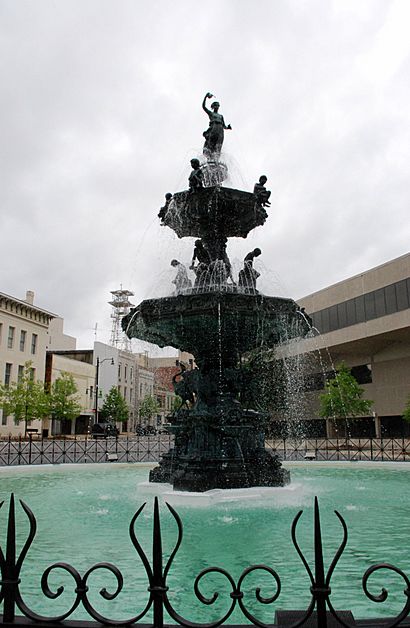Court Square Fountain facts for kids
Quick facts for kids Court Square Fountain |
|
|---|---|
 |
|
| Year | 1885 |
| Medium | Cast iron |
| Dimensions | (25 feet in) |
| Location | Montgomery, Alabama |
| 32°22′38″N 86°18′33″W / 32.37722°N 86.30917°W | |
The Court Square Fountain is a famous landmark in Montgomery, Alabama. It was built in 1885. This beautiful fountain sits on top of a natural underground water source called an artesian well. People, including Native Alabamians, used this well for water long before the city was settled.
The fountain features statues inspired by ancient Greek stories. The area around the fountain has a rich history. It was once a busy place for the slave trade. Many old buildings in this area have been torn down over time. The original statues on the fountain were replaced with aluminum ones in the 1980s.
Contents
The Court Square Fountain: A Historic Landmark
A Deep Well and Early History
The Court Square Fountain stands over a very old artesian well. This well was a vital watering spot for Native Alabamians for many years. By 1853, the well was 475 feet deep. It provided about two gallons of water every minute.
This location is also where two early communities, Alabama Town and New Philadelphia, grew together. They eventually formed the city we know today as Montgomery. Later, this area became a central point for the slave trade in Montgomery.
What the Fountain Looks Like
The Court Square Fountain is made of cast iron. For a long time, people thought a famous artist named Frederick MacMonnies designed it. But he said it wasn't his work.
At the very top of the fountain, there is a statue of Hebe. She is the Greek goddess of eternal youth. Below her, you can see other statues. There are four "Seated Boys" holding towels. Another layer down features four "Narcissus" figures. At the bottom, there is a group of three birds called "Stem Bitterns."
All these statues were originally made of zinc iron. However, they were replaced in 1984 with aluminum versions. Unfortunately, the aluminum statues started to corrode, or rust, because of chlorine in the water after only about 20 years.
Important Moments Nearby
The area around the fountain was once known as the "romantic center" of Montgomery. Many of the old buildings have been removed. For example, an entire block of historic buildings was torn down in the 1960s. This made way for a department store that opened in 1972.
Right across from the fountain is the Winter Building. This building is famous because the telegram ordering the attack on Fort Sumter was sent from there. This event started the American Civil War.
Also near the fountain is a bus stop. This stop is close to where Rosa Parks famously refused to give up her seat on a bus. Her brave act helped start the Montgomery Bus Boycott. This boycott was a very important part of the early Civil Rights Movement. It's important to note that Rosa Parks' refusal actually happened a bit further up the street, near where the Empire Theater used to be.
In 1888, Montgomery City rules stated that people should not bother the fish or birds in the fountain's basin. They also said not to put any liquids or solids into the fountain.
The statue of Hebe at the top of the fountain was probably inspired by a sculpture by Antonio Canova. You can find very similar fountains in other cities, like Bowling Green, Kentucky, and Memphis, Tennessee. All these fountains were made by a company called J.L. Mott Ironworks in New York.
The Fountain in Art
The Court Square Fountain has inspired artists and writers. Anne Goldthwaite, a painter born in Montgomery, featured the fountain in her painting Bringing Cotton Bails to Market. This painting shows a cotton wagon in front of the fountain.
Zelda Fitzgerald, a famous writer, played at the fountain when she was a child. Poet Andrew Hudgins also set one of his poems from his 2013 book, A Clown at Midnight, at the fountain.

